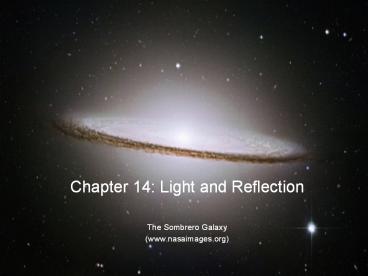Chapter 14: Light and Reflection - PowerPoint PPT Presentation
Title:
Chapter 14: Light and Reflection
Description:
Chapter 14: Light and Reflection The Sombrero Galaxy (www.nasaimages.org) Electromagnetic Waves What s comes to mind when you think of the word light? – PowerPoint PPT presentation
Number of Views:177
Avg rating:3.0/5.0
Title: Chapter 14: Light and Reflection
1
- Chapter 14 Light and Reflection
- The Sombrero Galaxy
- (www.nasaimages.org)
2
Electromagnetic Waves
- Whats comes to mind when you think of the word
light? - Generally people only think about sources that
produce light that is visible to humans
3
What is light?
- Light waves are electromagnetic waves
- Remember that electromagnetic waves do not need a
medium to propagate - Electromagnetic Wave A transverse wave
consisting of oscillating electric and magnetic
fields at right angles to each other.
4
EM Waves
5
Theres more than what the eye can see
- Not all light is visible to the human eye
- The complete electromagnetic spectrum contains
many different types of radiation
6
(No Transcript)
7
The electromagnetic spectrum
8
Remembering the Spectrum
- Rabbits Mate In Very Unusual Expensive Gardens
- Red Martians Invaded Venus Using X-Ray Guns
- From Longest Wavelength to Shortest Wavelength
Radio, Microwave, Infrared, Visible, Ultraviolet,
X-Ray, Gamma Ray
9
Why cant we see the other parts of the EM
spectrum?
- The Suns surface is brightest in the portion of
the spectrum that is visible to humans
http//apollo.lsc.vsc.edu/classes/met130/notes/cha
pter2/plank_e_sun.html
10
Does the Sun emit more than visible light
radiation?
White Light
http//sohowww.nascom.nasa.gov/
11
The Milky Way
12
Galaxy M101 Across the Spectrum
13
All EM waves travel at the speed of light
- Speed of light in a vacuum c 3.00 x 108 m/s
- Speed of light frequency x wavelength
14
Brightness
- Brightness at any point is the power per unit
area at that point (like sound intensity) - Brightness decreases by the square of the
distance from the source - i.e. if you move an object twice as far away from
a light source, one-fourth as much light falls on
it
15
How bright?
- Lets pretend that a person is looking at a
candle that is 1 m away from her. If the candle
were move to a distance of 3 m away, how would
the brightness change? - The candle would be 1/9 as bright
16
Section 14.2 Flat Mirrors
- Reflection The turning back of an
electromagnetic wave at the surface of a
substance
17
Enceladus(Moon of Saturn)
- Reflects 99 of EM waves
18
Iapetus (Moon of Saturn)
- Light regions Reflect 50-60 of EM Waves
- Dark Regions Reflect 2-5 of EM Waves
19
Reflection
- The texture of a surface affects how it reflects
light - Diffuse Reflection Rough, textured surfaces
reflect light in many different directions - Specular Reflection Smooth, shiny surfaces (i.e.
water) reflect light in one direction
20
Specular vs Diffuse Reflection
Specular Reflection Diffuse Reflection
- When the book says reflection, it means specular
reflection
21
Basic Reflection
- Angle of Incidence (?) Angle of Reflection (?)
22
Angles
- Angle of Incidence (?) The angle between the
incoming light ray and the line perpendicular to
the surface - Angle of Reflection (?) The angle between the
reflected light ray and the line perpendicular to
the surface
23
Flat Mirrors
- Flat Mirrors are the simplest type of mirror
- When an object is placed in front of a flat
mirror, light rays will spread out from the
object and reflect from the mirrors surface - Virtual Image An image formed by light rays that
only appear to intersect
24
Flat (Plane) Mirror Images
- The image produced is upright
- The image is the same size as the object (i.e.,
the magnification is m 1) - The image is the same distance from the mirror as
the object appears to be (i.e., the image
distance the object distance) - The image is a virtual image































